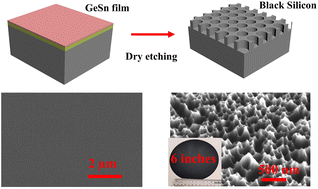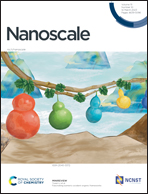Wafer-scale nanostructured black silicon with morphology engineering via advanced Sn-assisted dry etching for sensing and solar cell applications†
Abstract
Black-Si (b-Si) providing broadband light antireflection has become a versatile substrate for photodetectors, photo-electric catalysis, sensors, and photovoltaic devices. However, the conventional fabrication methods suffer from single morphology, low yield, or frangibility. In this work, we present a high-yield CMOS-compatible technique to produce 6-inch wafer-scale b-Si with diverse random nanostructures. b-Si is achieved by O2/SF6 plasma-based reactive ion etching (RIE) of the Si wafer which is coated with a GeSn layer. A stable grid of the SnOxFy layer, formed during the initial GeSn etching, acts as a self-assembled hard mask for the formation of subwavelength Si nanostructures. b-Si wafers with diverse surface morphologies, such as the nanopore, nanocone, nanohole, nanohillock, and nanowire were achieved. Furthermore, the responsivity of the b-Si metal–semiconductor–metal (MSM) photodetector in the near-infrared (NIR) wavelength range (1000–1200 nm) is 40–200% higher than that of a planar-Si MSM photodetector with the same level of dark current, which is beneficial for applications in photon detectors, solar cells, and photocatalysis. This work not only demonstrates a new non-lithography method to fabricate wafer-scale b-Si wafers, but may also provide a novel strategy to fabricate other nanostructured surface materials (e.g., Ge or III–V based compounds) with morphology engineering.



 Please wait while we load your content...
Please wait while we load your content...